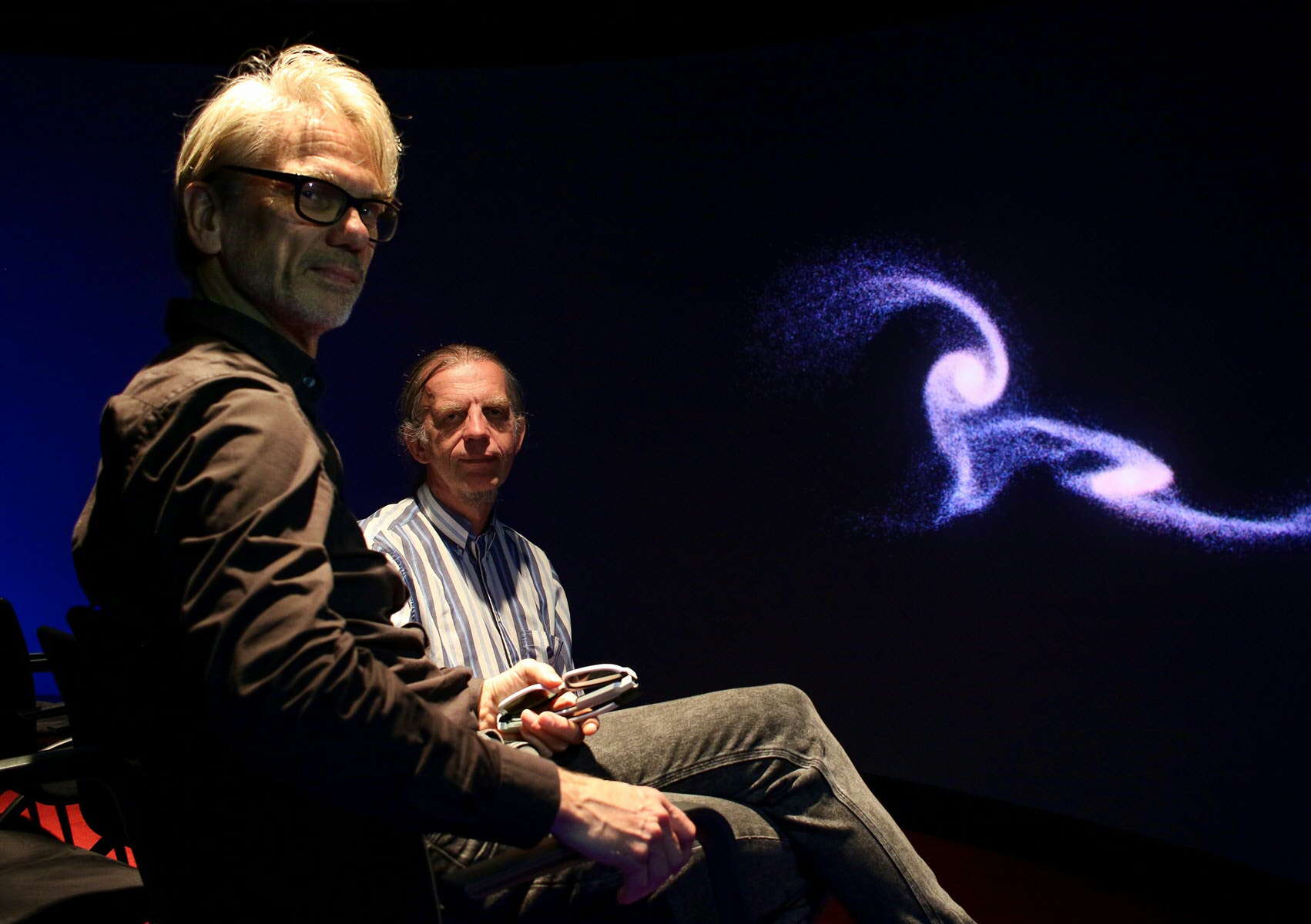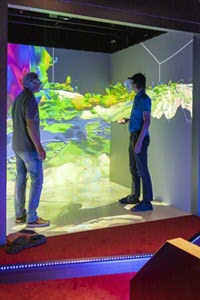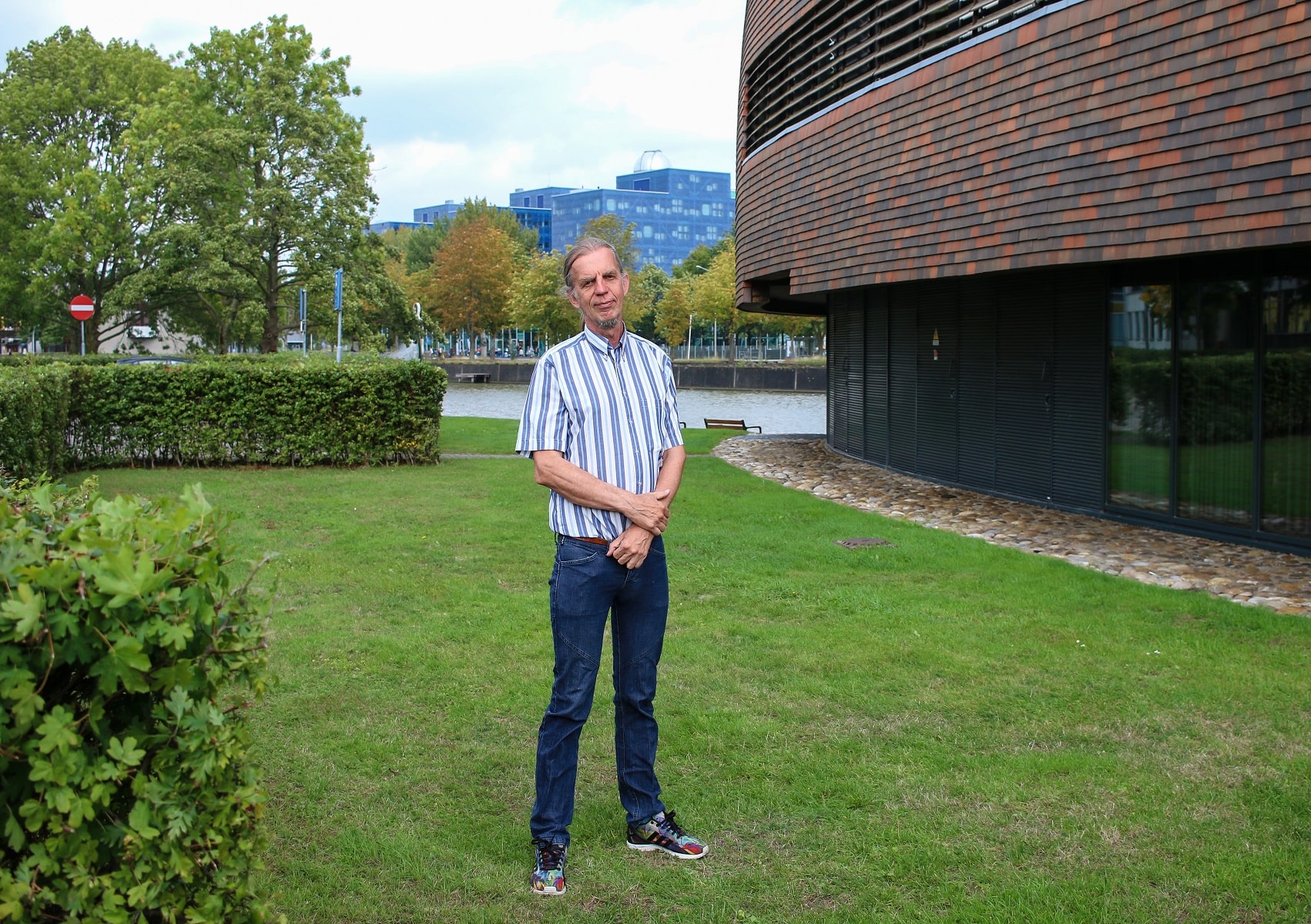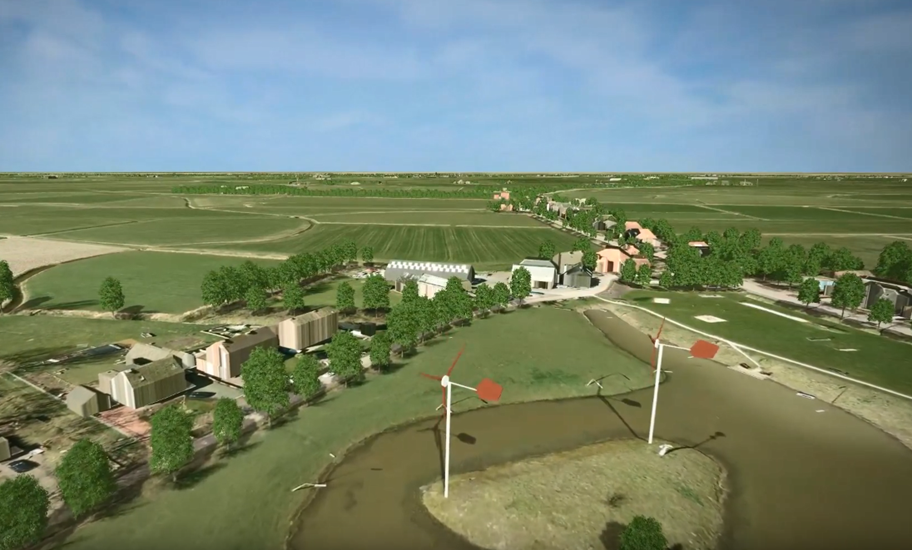Virtual reality wordt steeds reëler

De behandeling van fobieën, psychologische experimenten, botten identificeren, een virtuele stad: de mogelijkheden van virtual reality (VR) zijn eindeloos. Door de toenemende populariteit van VR proberen steeds meer docenten en onderzoekers het in te zetten bij hun werkzaamheden. Het Reality Center van de RUG biedt hen daarbij de helpende hand. Frans van Hoesel: ‘Mensen zijn vaak verbaasd over wat er allemaal mogelijk is. Doe mij een voorstel van hoe je virtual reality zou willen toepassen, en negen van de tien keer kan het al.’
Tekst: Nynke Broersma / Foto's: Hesterliena Wolthuis
Van Hoesel is hoofd van het Reality Center, een afdeling binnen de RUG die verschillende VR-toepassingen ontwikkelt. Op zijn visitekaartje prijkt de titel Illusion Manager. ‘Waarom ik mezelf zo noem? Heel simpel: virtual reality is de ultieme vorm van illusie’. In het Reality Center is het meest sprekende voorbeeld hiervan misschien wel de Reality Cube: een kubus waarbij op drie wanden en de vloer 3D-beelden worden geprojecteerd. Door deze ‘onderdompeling’ kunnen virtuele situaties dezelfde gevoelens oproepen als echte situaties, waardoor de Cube uitermate geschikt is voor bijvoorbeeld exposure therapie. ‘We hadden hier ooit een meisje met hoogtevrees. Het duurde een half uur voor ze zelfs maar een stap durfde te zetten richting de virtuele afgrond. Dat zegt wel iets over hoe echt het ervaren wordt’, zegt Van Hoesel.

Psychologische experimenten
Hoewel exposure therapie in echte vliegtuigen of met echte spinnen al langere tijd wordt toegepast, heeft de zogeheten Virtual Reality Exposure Therapie (VRET) een groot aantal voordelen. Zo kunnen de begeleidende psychologen de situatie aanpassen als dat nodig is en vinden cliënten het vaak laagdrempeliger dan oefenen met echte situaties. Bovendien kan dezelfde situatie exact herhaald worden, waardoor de Reality Cube ook zeer geschikt is voor psychologische experimenten. Een goed voorbeeld van onderzoek wat hier is uitgevoerd is het Chicken Experiment. Deelnemers lopen hierbij door een virtueel gangenstelsel waarbij ze een aantal keer een virtuele tegenligger tegenkomen. Voor wie stap je aan de kant? En wat zegt dat over stereotypering? ‘Natuurlijk kun je dit ook met acteurs als tegenliggers doen. Maar de kans dat een acteur de ene dag precies hetzelfde doet als de andere dag is miniem. In de Reality Cube kan een experiment exact herhaald worden, waardoor de resultaten betrouwbaarder worden’, legt van Hoesel uit.

Méér dan head-mounted displays
Het gebruik van VR in de psychologie is slechts één voorbeeld van de vele mogelijkheden. Toch weet een deel van de onderzoekers en wetenschappers het Reality Center nog niet te vinden. Waar ligt dat aan? Van Hoesel: ‘Ik spreek weleens op inspiratiedagen en dan merk je dat mensen verbaasd zijn over wat er allemaal mogelijk is. Als ze met een idee komen blijkt het in negen van de tien gevallen al te kunnen. Wij kunnen helpen die ideeën uit te voeren.’ Bovendien denken veel mensen volgens Van Hoesel bij VR vooral aan de head-mounted display (de VR-bril die je op je hoofd draagt). ‘Maar het Reality Center heeft, naast de Reality Cube, ook nog een Reality Theatre. Dit theater heeft een interactief 3D-scherm van acht meter breed en negentien zitplekken, wat extra mogelijkheden biedt. Om een voorbeeld te noemen: vorig jaar hebben we een visualisatie gemaakt van Middag-Humsterland, een beschermd landschap waar windmolens geplaatst zouden worden. De visualisatie hebben we gepresenteerd aan een aantal vertegenwoordigers van de gemeente. Zij konden hierdoor niet alleen letterlijk het nieuwe landschap voor zich zien, maar ook meteen met elkaar in gesprek gaan over de voor- en nadelen van de plannen en de noodzakelijke veranderingen doorvoeren.’

Botten bestuderen met virtual reality
Ook in het onderwijs zijn er heel veel manieren om VR in te zetten, stelt André Rosendaal. Hij is namens Letteren betrokken bij de V/AR hub: een samenwerking tussen het Reality Center en diverse faculteiten van de RUG. De faculteiten kunnen hierbij gebruik maken van het VR-Lab, een ruimte in het Reality Center waar verschillende VR-toepassingen ontwikkeld én gebruikt kunnen worden. Ook kunnen faculteiten kennis en ervaringen uitwisselen en kijken naar de mogelijkheden om samen projecten op te zetten. Rosendaal: ‘Ik hoop dat docenten en onderzoekers zich meer gaan realiseren dat VR een hele goede tool is om te experimenteren en te leren.’
Een mooi voorbeeld hiervan is de door het Reality Center en de opleiding Archeologie ontwikkelde tool Bonify. Studenten houden hierbij kaartjes van botten voor de VR-bril die ze dragen, waarna een 3D-versie van het bot in beeld verschijnt. Ze zien door de VR-bril het echte bot dat zij in hun hand houden en tegelijkertijd de 3D-afbeelding, om zo makkelijker te kunnen achterhalen met welk bot ze te maken hebben en van welk dier het afkomstig is. Door het kaartje te draaien kunnen ze het virtuele bot van alle kanten in detail bestuderen.

Een VR-lab bij elke faculteit?
De mogelijkheden zijn er, maar wordt VR ooit de norm? Van Hoesel werkt lang genoeg bij de RUG om te weten dat het soms lang duurt voordat innovaties ook echt toegepast worden: 'Je kan nu al een hele lijst van artikelen vinden met de voordelen van VR voor onderzoek en onderwijs. Het duurt even, maar mensen gaan er steeds meer mee experimenteren. Je merkt dat er nu al meer aandacht voor is op congressen. Bovendien wordt het steeds goedkoper.'
Het wordt daarmee ook steeds reëler dat VR een grote rol gaat spelen in onderwijs en onderzoek. Rosendaal: ‘Studenten zullen na hun afstuderen steeds vaker te maken krijgen met VR-toepassingen in het beroepsveld, zowel binnen onderzoek als daarbuiten. Daarom denk ik dat studenten, docenten en onderzoekers er baat bij zouden hebben een VR-Lab in de eigen faculteit te hebben. Om hun kennis van VR te vergroten, maar vooral ook om ervaring op te doen met het gebruik van de verschillende toepassingen.’
Van Hoesel en Rosendaal hopen dat tot die tijd onderzoekers en docenten eerder hun weg vinden naar het Reality Center en naar de V/AR hub. ‘Als mensen zelf een plan hebben lopen ze vaak vast bij de verdere ontwikkeling. Wij hebben alle kennis in huis, en die willen we graag delen!’
Meer informatie
Frans van Hoesel
André Rosendaal
